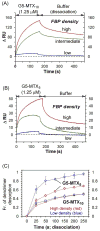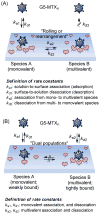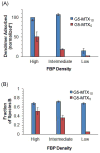Avidity modulation of folate-targeted multivalent dendrimers for evaluating biophysical models of cancer targeting nanoparticles
- PMID: 23855478
- PMCID: PMC3783574
- DOI: 10.1021/cb400258d
Avidity modulation of folate-targeted multivalent dendrimers for evaluating biophysical models of cancer targeting nanoparticles
Abstract
We investigated two types of generation 5 polyamidoamine (PAMAM) dendrimers, each conjugated stochastically with a mean number of 5 or 10 methotrexate (MTX) ligands per dendrimer (G5-MTX5, G5-MTX10), for their binding to surface-immobilized folate binding protein (FBP) as a function of receptor density. The binding study was performed under flow by surface plasmon resonance spectroscopy. Two multivalent models were examined to simulate binding of the dendrimer to the receptor surface, showing that at relatively high receptor density, both dendrimer conjugates exhibit high avidity. However, upon reducing the receptor density by a factor of 3 and 13 relative to the high density level, the avidity of the lower-valent G5-MTX5 decreases by up to several orders of magnitude (KD = nM to μM), whereas the avidity of G5-MTX10 remains largely unaffected regardless of the density variation. Notably, on the 13-fold reduced FBP surface, G5-MTX5 displays binding kinetics similar to that of monovalent methotrexate, which is patently different from the still tight binding of the higher-valent G5-MTX10. Thus, the binding analysis demonstrates that avidity displayed by multivalent MTX conjugates varies in response to the receptor density and can be modulated for achieving tighter, more specific binding to the higher receptor density by modulation of ligand valency. We believe this study provides experimental evidence supportive of the mechanistic hypothesis of multivalent NP uptake to a cancer cell over a healthy cell where the diseased cell expresses the folate receptor at higher density.
Figures







Similar articles
-
Folate Receptor-Targeted Dendrimer-Methotrexate Conjugate for Inflammatory Arthritis.J Biomed Nanotechnol. 2015 Aug;11(8):1431-41. doi: 10.1166/jbn.2015.2077. J Biomed Nanotechnol. 2015. PMID: 26295143
-
Mechanisms and implications of dual-acting methotrexate in folate-targeted nanotherapeutic delivery.Int J Mol Sci. 2015 Jan 13;16(1):1772-90. doi: 10.3390/ijms16011772. Int J Mol Sci. 2015. PMID: 25590303 Free PMC article. Review.
-
Poly(amidoamine) dendrimer-methotrexate conjugates: the mechanism of interaction with folate binding protein.Mol Pharm. 2014 Nov 3;11(11):4049-58. doi: 10.1021/mp500608s. Epub 2014 Oct 1. Mol Pharm. 2014. PMID: 25222480 Free PMC article.
-
Polyvalent dendrimer-methotrexate as a folate receptor-targeted cancer therapeutic.Mol Pharm. 2012 Sep 4;9(9):2669-2676. doi: 10.1021/mp3002232. Epub 2012 Aug 7. Mol Pharm. 2012. PMID: 22827500 Free PMC article.
-
99mTc-Labeled acetylated dendrimer poly(amido)-amine generation 5-PEGylated folic acid-2-(p-isothiocyanatobenzyl)-6-methyl-diethylenetriamine pentaacetic acid conjugate.2011 Mar 15 [updated 2011 Apr 21]. In: Molecular Imaging and Contrast Agent Database (MICAD) [Internet]. Bethesda (MD): National Center for Biotechnology Information (US); 2004–2013. 2011 Mar 15 [updated 2011 Apr 21]. In: Molecular Imaging and Contrast Agent Database (MICAD) [Internet]. Bethesda (MD): National Center for Biotechnology Information (US); 2004–2013. PMID: 21542551 Free Books & Documents. Review.
Cited by
-
Folic acid-decorated polyamidoamine dendrimer mediates selective uptake and high expression of genes in head and neck cancer cells.Nanomedicine (Lond). 2016 Nov;11(22):2959-2973. doi: 10.2217/nnm-2016-0244. Epub 2016 Oct 26. Nanomedicine (Lond). 2016. PMID: 27781559 Free PMC article.
-
Multivalent polymers for drug delivery and imaging: the challenges of conjugation.Biomacromolecules. 2014 Sep 8;15(9):3215-34. doi: 10.1021/bm500921q. Epub 2014 Aug 22. Biomacromolecules. 2014. PMID: 25120091 Free PMC article. Review.
-
Avidity mechanism of dendrimer-folic acid conjugates.Mol Pharm. 2014 May 5;11(5):1696-706. doi: 10.1021/mp5000967. Epub 2014 Apr 11. Mol Pharm. 2014. PMID: 24725205 Free PMC article.
-
Engineering Tumour Cell-Binding Synthetic Polymers with Sensing Dense Transporters Associated with Aberrant Glutamine Metabolism.Sci Rep. 2017 Jul 20;7(1):6077. doi: 10.1038/s41598-017-06438-y. Sci Rep. 2017. PMID: 28729677 Free PMC article.
-
Enhanced transfection efficiency and targeted delivery of self-assembling h-R3-dendriplexes in EGFR-overexpressing tumor cells.Oncotarget. 2015 Sep 22;6(28):26177-91. doi: 10.18632/oncotarget.4614. Oncotarget. 2015. PMID: 26309162 Free PMC article.
References
-
- Kukowska-Latallo JF, Candido KA, Cao Z, Nigavekar SS, Majoros IJ, Thomas TP, Balogh LP, Khan MK, Baker JR., Jr Nanoparticle Targeting of Anticancer Drug Improves Therapeutic Response in Animal Model of Human Epithelial Cancer. Cancer Res. 2005;65:5317–5324. - PubMed
-
- Low PS, Henne WA, Doorneweerd DD. Discovery and Development of Folic-Acid-Based Receptor Targeting for Imaging and Therapy of Cancer and Inflammatory Diseases. Acc Chem Res. 2008;41:120–129. - PubMed
Publication types
MeSH terms
Substances
Grants and funding
LinkOut - more resources
Full Text Sources
Other Literature Sources
Medical
Miscellaneous

